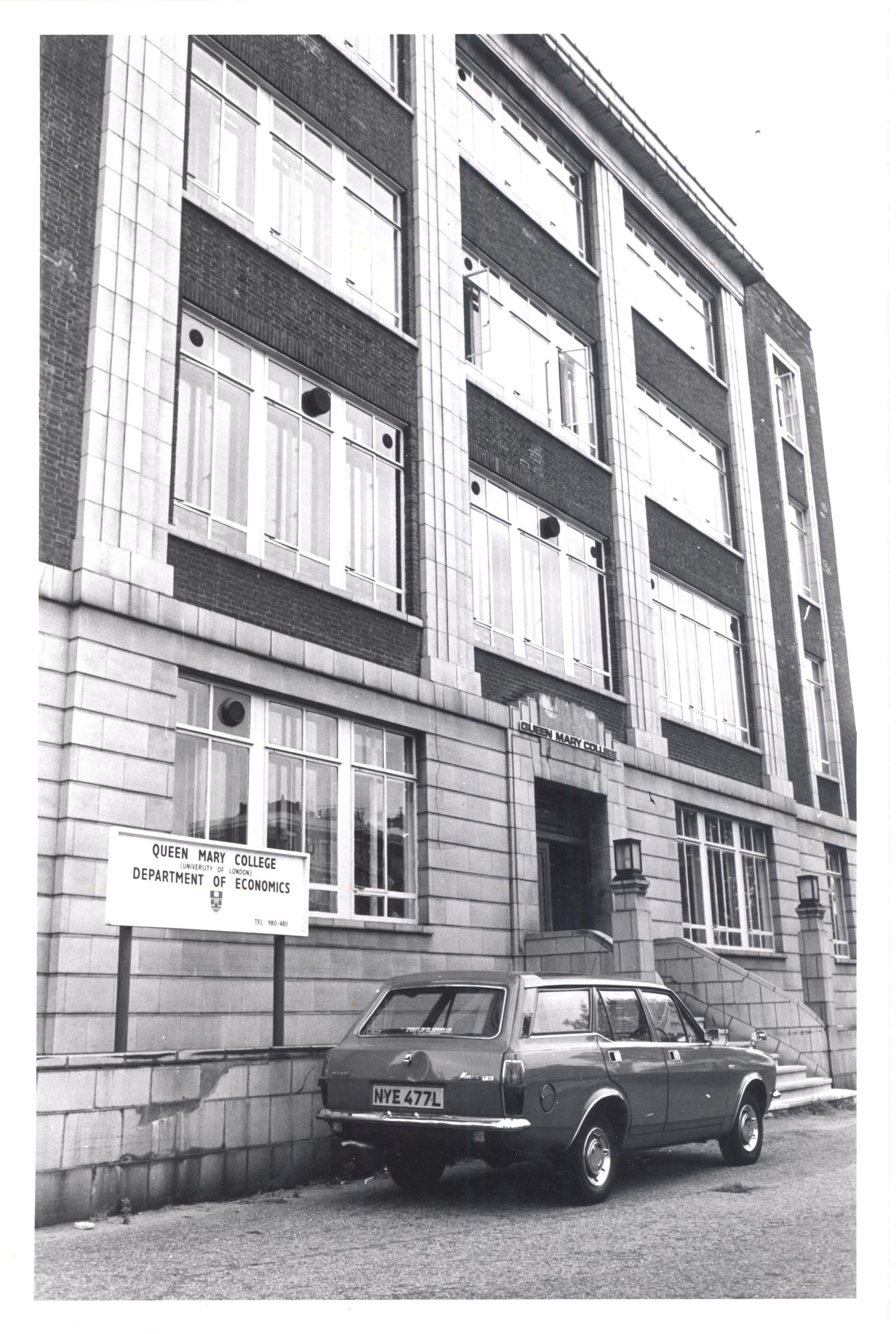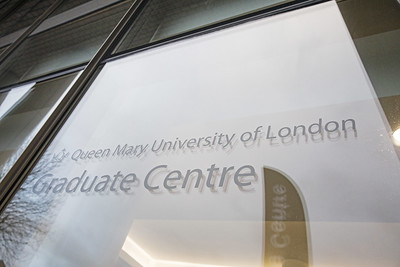History and Legacy of the School
We are proud of our distinguished history at the School of Economics and Finance.
 The impetus for the opening of the School of Economics and Finance came from a piece of ground-breaking social policy research led by an economist, Lionel Robbins. Published in 1963, and commissioned by Harold Macmillan’s Conservative government, the Robbins Report into higher education argued that many talented people were being denied the opportunity of a university education because there weren’t enough places. At the time, only 5% of young people in Britain went to university, and only a quarter of them were women. The report called for a dramatic expansion of the university sector, the aim being to get to a point where anyone with the necessary qualifications could go to university if they wanted to.
The impetus for the opening of the School of Economics and Finance came from a piece of ground-breaking social policy research led by an economist, Lionel Robbins. Published in 1963, and commissioned by Harold Macmillan’s Conservative government, the Robbins Report into higher education argued that many talented people were being denied the opportunity of a university education because there weren’t enough places. At the time, only 5% of young people in Britain went to university, and only a quarter of them were women. The report called for a dramatic expansion of the university sector, the aim being to get to a point where anyone with the necessary qualifications could go to university if they wanted to.
The report led to Sir Thomas Creed, the Principal of Queen Mary College, as it was then, to set up two new departments, one in law and the other in economics. In 1965, Creed recruited Maurice Peston, a young reader in economics from the LSE, as Queen Mary’s first Professor of Economics. It was an astute appointment. Maurice Peston would go on to become one the leading public policy economists of that generation, working as a special advisor to two cabinet ministers, Reg Prentice and Roy (now Lord) Hattersley in the 1970s, amongst a number of political advisory appointments over four decades. In 1987, he was appointed to the House of Lords, where he worked as Labour peer speaking on issues such as education, energy and the economy, until his recent death in April 2016. In his first few years at Queen Mary (he worked here until retiring as emeritus professor in 1988) Peston also proved to be very capable at negotiating the challenges of setting up a university department from scratch.
One of Peston’s first appointments in the new School was a political economist, Trevor Smith, later to become Professor Lord Smith, who worked at Queen Mary from 1967 to 1991, becoming a senior vice-principal, before leaving to take on the role of vice-chancellor of Ulster University. Lord Smith remembers Maurice Peston as being: “Blessed with a brilliant mind. He could search through a host of silo thoughts, sort out the wheat from the chaff, and then produce an original thought-provoking synthesis. He was always on the look-out for new ways of discovering solutions to difficult, preferably seemingly intractable, problems.”
One of the first problems Peston had to solve at Queen Mary was how to find enough economists for the Department. Professor Victor Bulmer-Thomas, who joined the Department in 1978 as a lecturer in development economics, and worked there until 1998, explains: “One of the interesting things about economics departments set up then is that very often they had to recruit non-economists, because relatively few people had trained in economics. At Queen Mary, you had a physicist, as well as people who had done accountancy or engineering."
This open-minded approach to recruitment enabled Peston to assemble a talented team of young academics. In 1966, the year the Department opened, in addition to Peston, there was one lecturer, Adrian Ziderman, and three assistant lecturers, Ray Rees, Alan Coddington and AP Ellison. Between them, they were responsible for teaching 50 new students of economics. Two years later, in 1968, Peston was able to make another key appointment, recruiting the Department’s second professor of economics, Bernard Corry, a specialist in economic thought from the LSE. Both Peston and Corry had studied under Lionel Robbins at the LSE. Indeed, their connection went back further. Both had grown up in the East End, and had gone to Hackney Downs School together, where the playwright Harold Pinter was a fellow pupil.
 By 1970, the Department had a full complement of economics staff, including new recruits Patricia Dillon, Dick Allard, John Healey, DR Croome and Alf Vanags. Trevor Smith was also joined by another lecturer in government and political science, Elizabeth Vallance. In those early years the number of students grew steadily, with around 70 undergraduate students joining each year, 50 to study economics, and 10 each to study economics and geography, and economic history. In 1970, however, there was a significant leap in the number of postgraduate students, with the Department taking in 44 students, more than double the previous year. That year’s annual report notes: “Although this meant the staff were overburdened, the academic achievements of the Department made it worthwhile,” a reference to the four first class undergraduate degrees and a masters distinction awarded that year.
By 1970, the Department had a full complement of economics staff, including new recruits Patricia Dillon, Dick Allard, John Healey, DR Croome and Alf Vanags. Trevor Smith was also joined by another lecturer in government and political science, Elizabeth Vallance. In those early years the number of students grew steadily, with around 70 undergraduate students joining each year, 50 to study economics, and 10 each to study economics and geography, and economic history. In 1970, however, there was a significant leap in the number of postgraduate students, with the Department taking in 44 students, more than double the previous year. That year’s annual report notes: “Although this meant the staff were overburdened, the academic achievements of the Department made it worthwhile,” a reference to the four first class undergraduate degrees and a masters distinction awarded that year.
Certainly the first generations of Queen Mary economics students vindicated Lionel Robbins’ argument for the need to expand higher education to accommodate talent, with a number going on to high-profile careers. They include Dame Colette Bowe, former Chair of Ofcom; Lord Peter Hain, Labour Party politician, and former MP and Cabinet Minister; Sir Richard Broadbent, former Executive Chairman of Her Majesty's Customs and Excise and former Chairman of Tesco; David Sullivan, multi-millionaire publisher and co-chairman of West Ham Football Club; Charles Rose, an entrepreneur specialising in renewable energies; and Professor Diana Green CBE, former Vice-Chancellor of Sheffield Hallam University. The students were quick to make an impression on the life of the university too. At the student Economics Society’s first dinner in 1966, the guest speaker was the Head of the Government Economic Service, Sir A K Cairncross, a sign of the ambition and initiative of this new intake.
The character of the School
In its early years, due to a lack of space on the main campus – this was long before the university had expanded its boundaries to Regent’s Canal – the Economics Department was based in a building nearly a mile to the east of the Queens’ Building at 41-47 Bow Road. Officially known as the “Bow Road extension”, its location away from the university gave the department a distinctive identity ¬– in fact, it was sometimes referred to as “the East London School of Economics”. Professor Stephen Pollock, who joined the department in 1972 and taught here until 2007, remembers it as, “Quite a small, cohesive and enthusiastic department.” He also recalls that 41-47 Bow Road was known to some as “Spratts”, a reference to the fact that the building had previously been the head office of Spratts Patent Ltd, a pet food manufacturer, who specialised in turning fish heads into dog biscuits at a large factory in nearby Poplar.
One of the features of the Department in those early years was its strength in public policy work, with projects in manpower planning, education, cost-benefit analysis in transport, industrial training, defence, and foreign policy spending. In 1971, the university’s annual report states that “major progress” was made on the construction of “an econometric model of the UK economy”, with Maurice Peston also completing research on local education authority planning and Bernard Corry completing an analysis of UK labour force participation rates. In that year, Maurice Peston published articles in a diverse range of trade, academic and news publications, including the Times Education Supplement, Bankers’ Magazine, Race Today, Political Quarterly, the New Academic, and the Guardian, the common thread being his interest in the relevance of economics research to the real-world. The strengths of the Department in this area were also reinforced by the presence of its own lecturers in political science. It was a significant turning point, then, in 1975, when a separate Department of Politics was created out of the Department of Economics. However, relationships between the two Departments remained close, as they continued to share a home on Bow Road.
In the following year, new buildings on the main campus enabled both Departments to move into the Queens’ Building, where they shared the third floor. In the 1976 annual report, the Principal, Sir James Menter, welcomed “the end to the exile” of the economics Department. In 1985, after nearly 20 years of working in or alongside Economics, the Department of Politics moved into its own building close to Regent’s Canal. In the annual report of 1985, the Department of Economics reflected that: “The loss of their stimulating company has to some extent been balanced by our acquisition of a very small part of the space vacated,” a hint at the internal tensions that a lack of space on campus was creating for the university at the time.
Innovative courses, curriculum and research
Alongside its early interest in public policy work, over the years the Department developed broad expertise in the various sub-fields of economics, taking in micro and macroeconomics, economic theory, econometrics, development economics and applied economics. There have also been some more unusual and innovative courses offered along the way. For example, in 1970, the Department launched a BSc(Econ) course in Economics and Nursing that was run jointly with the School of Nursing at The London Hospital for “students interested in using economic analysis and techniques in their nursing careers”. And in 1988, a masters specialising in the economics of Latin America was launched, the only course of its kind in the UK. The course was set up by development economist Professor Victor Bulmer-Thomas, a specialist in Latin American economics, with the support of the then head of department, Professor David Currie (now Lord Currie). The MSc ran for ten years until Professor Bulmer-Thomas left the university in 1998. He later went on to become the Director of Chatham House. Each year, the course took on around 10 students, the majority of whom came from Latin America. Alumni have gone on to a range of high-profile positions, including the lead economist at the Inter-American Development Bank, the president of the central bank in Ecuador, a presidential advisor in El Salvador, and deputy governor of the central bank in Trinidad and Tobago.
The School today

Recalling how the department was seen in its early years, Professor Bulmer-Thomas, says: “When I joined in 1978, neither the Department nor the College were fashionable. It was sort of a statement to work or study there – that you were not going to be seduced by the shallow reputation associated with better-known places. We knew we were a little bit different, and would have to earn our reputation, rather than being given it on a plate.” Of course, these days the School of Economics and Finance, as it now is, has firmly established its reputation. A key turning point came in 2001, when it received a 5, one of the top ratings in the Research Assessment Exercise of that year, significantly raising its profile. In 2016, it has more than 550 undergraduate students, 750 postgraduates and offers five undergraduate programmes, and 12 taught masters programmes. The School owes much to the vision and tenacity of the late Lord Maurice Peston, whose memory lives on in the annual Peston Lecture, held in his honour.
In 2016, the School of Economics and Finance celebrated its 50th Anniversary. That year’s commemorative lecture was delivered by the Governor of the Bank of England, Mark Carney, an indication of its prestigious place in British public discourse. Carney used the lecture as a platform to announce that the Bank of England would not be raising interest rates for the foreseeable future, prompting an immediate response on the world’s stock markets. Still alive at the time, the 84-year-old Lord Peston surely enjoyed this emphatic illustration of what can happen when economics and public policy meet.
Economics Master's Apprenticeship Programme (EMAP)
In July 2020, The Department for Business, Energy & Industrial Strategy (BEIS) launched a public tender for comprehensive project support to design, deliver and ensure a new Senior Economist Masters Apprenticeship Programme (EMAP) across multiple government departments and agencies. In August 2020, BEIS awarded the contract to Queen Mary University and the School of Economics and Finance.
The programme, which has been developed with senior government economists, is designed to increase the flow of junior economists into senior management roles in participating organisations, helping to address current skills shortages, promote career advancement, and foster diversity within the Senior Civil Service. It also provides learners the academic and professional skills they need to advance their career and become a senior economist within the civil service. It is also a chance for the school to develop and deliver economic content, impact future policy makers, and build networks with civil service.
The programme serves to contribute to the school's and Queen Mary's broader EDI objective by reflecting the vision and identity of the university as well as expanding the scope and diversity of the economics profession.
To date, this is the University's largest degree apprenticeship programme with 1-2 intakes a year from February 2021 and expected to run for a minimum of 3-4 years. For more information, you can see our dedicated EMAP page.
Key Dates in the School's History
1965 - Professor Maurice Peston (founder) was appointed to set up the department of Economics
1966 - the Department officially opened teaching 50 new students of economics
1970 - a significant leap in the number of postgraduate students, with the Department taking in 44 students
2010 - renaming of the department as the School of Economics and Finance, introducing a portfolio of finance-related Master's
2016 - the School of Economics and Finance celebrated its 50th Anniversary
2020 - SEF launches an MSc Economics, level 7 degree apprenticeship developed with senior UK government economists.
2022 - SEF launches BSc Applied Finance, levels 4 and 6 degree apprenticeship, in collaboration with Goldman Sachs.
Acknowledgements
Thanks to former members of the Department of Economics, Professor Bulmer-Thomas, Professor Steven Pollock, Professor Simon Mohun and Professor Lord (Trevor) Smith for their help with this article. Thanks also to Dr Elise Gourier, Lecturer in Finance, Emma Levy, the School of Economics and Finance’s Marketing Manager, and the archive team at Queen Mary University of London.
*Economics moved from the Bow Road building (pictured above) into the main Queen Mary building on the Mile End campus in 1976. The lease on the Bow Road building was given up in 1981.
This page was last updated May 2022
